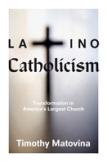America's New Face
The “browning of America” or the increase of the population of Americans of non-European ancestry, especially from Mexico and other parts of Latin America, and the social metamorphoses that accompanies it, first came to the attention of the public at large in a Time magazine cover story on April 9, 1990. In the past decades Latinos or Hispanics have surpassed African-Americans to become the largest minority group in the United States. According to the U.S. Census Bureau, the Latino population is just over 50 million, or 16.3 percent of the total population in March 2012. And some demographers, including those at the Pew Research Center, predict that the relative youthfulness of the Hispanic population in the United States and its comparatively high birth rate will probably ensure that by the year 2050 people of Hispanic ancestry will constitute close to 30 percent of the country’s population.
Latino Catholicism: Transformation in America’s Largest Church, by Timothy Matovina, a professor of theology at the University of Notre Dame and director of the Cushwa Center for the Study of American Catholicism, contributes to the many studies of the so-called “browning” of the United States by focusing on the impact that Latinos are having on the United States’ largest religious denomination.
Though not Latino himself, Matovina has written extensively, sympathetically and insightfully on Mexican-American religious experience and history, especially in San Antonio, Tex., and in particular associated with the devotion to Our Lady of Guadalupe. His latest endeavor casts the net wider and skillfully examines the role not only of Mexican-Americans but of other Latino groups in the United States, and how U.S. society, the Catholic Church and the various Latino peoples of the United States are interacting to reciprocally transform each other.
His methodology is interdisciplinary, and depending on the chapter, Matovina brings the perspective of a historian, sociologist, political scientist and pastoral theologian or a combination of these. This use of various hermeneutics is an effective way to plumb the vibrant and multidimensional experience that is Latino Catholicism, made up of various generations and populated by people from more than 20 Latin American countries, some recently arrived, others who have lived here for decades and many who were born here.
About the only perspective on Latino religious experience that is missing is a more literary one that would present it through the lenses of contemporary writers who have chronicled it in their fiction and nonfiction works, for example Julia Alvarez, Gloria Anzaldúa, Ana Castillo, Oscar Hijuelos, Nicholasa Mohr, Pat Mora, Judith Ortíz Cofer, Richard Rodríguez, Esmeralda Santiago and Pirri Thomas, to name a few. Regardless, Matovina’s eclectic approach makes this volume unique among studies of Latino Catholics in the United States and goes beyond them in that others have been more historical or theological in nature. Examples include David Badillo’s Latinos and the New Immigrant Church (2006) and Hispanic Ministry in the 21st Century: Present and Future (2010), edited by Hosffman Ospino.
Matovina’s book begins with a chapter on Hispanics in U.S. Catholic history and in eight other chapters considers integration, pastoral ministry among Latinos, Hispanic parishes and apostolic movements, leadership in the Latino Catholic community, worship and spirituality, Latino Catholicism in the public square and faith formation practices and challenges in the Latino Catholic community.
Latino Catholicism is characterized by issues similar to those one finds in mainstream U.S. Catholicism—for example, declining religious practices and increasing religious illiteracy among Catholics across the board, but especially among younger generations. However, it is a qualitatively different way of living out the same creed that all U.S. Catholics embrace. Among the differences that Matovina describes very well are Hispanic ministry efforts that marry the preservation of Latino cultural traditions with pastoral ministry. He also includes church-sponsored community organizing efforts for the poor; advocacy and organizing around immigration reform; culturally appropriate and sensitivity training programs for seminarians and lay ecclesial ministers; lobbying for more Latino bishops; and non-parish-based spiritualities, often domestic, that are more Marian, charismatic and linked to apostolic movements like Cursillo than is the norm among most U.S. Catholics.
Perhaps the most often asked question about Latino Catholicism’s future is how quickly will Latinos follow the pattern of other Catholic immigrants to these shores and assimilate into the U.S. mainstream? How quickly will they adopt English as their primary language and embrace American customs and cease to be distinctively Latinos, other than by their surnames? The short answer to the question is that no one knows for sure. Matovina’s treatment of the issue is characteristic of the irenic and insightful approach of this book. He notes that according to the 2010 U.S. Census, nearly 70 percent of Latinos are U.S. born. And a 2003 study of high school-age Latinos showed that 15 percent speak primarily Spanish, 60 percent are bilingual, and 25 percent speak English with little or no Spanish spoken. These figures augur for a future similar to that of other Catholic ethnic groups (especially Italian-Americans), in terms of assimilation to the English language and U.S. culture.
Yet Matovina offers a caution: “Collectively Latinos neither rapidly assimilate nor indefinitely retain Spanish language and their allegiance to Hispanic cultural ways... The ongoing accommodation to U.S. church and society among Latinos has transpired concurrently with the arrival of other Hispanic newcomers since at least the first decades of the twentieth century.” Matovina convincingly argues that this pattern suggests a future for the Hispanic presence in U.S. Catholicism that comingles both assimilation and cultural retention, which “will persist much longer than it did for European immigrant groups.” And this cautious but realistic prediction, it seems to me, could not be a better endorsement for a book that so clearly and thoroughly describes what will be the majority face of Catholicism in the United States for decades to come.
This article also appeared in print, under the headline “America's New Face,” in the June 4, 2012, issue.








